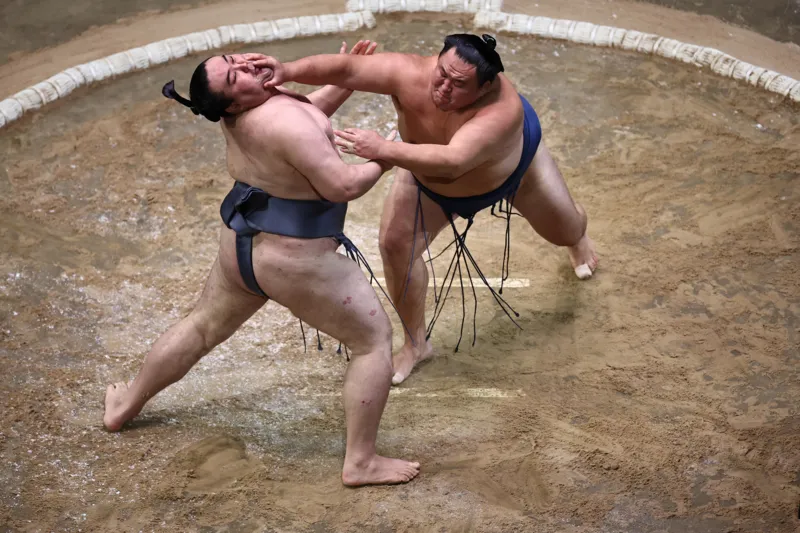Flora DruryThe Royal Albert Hall, London
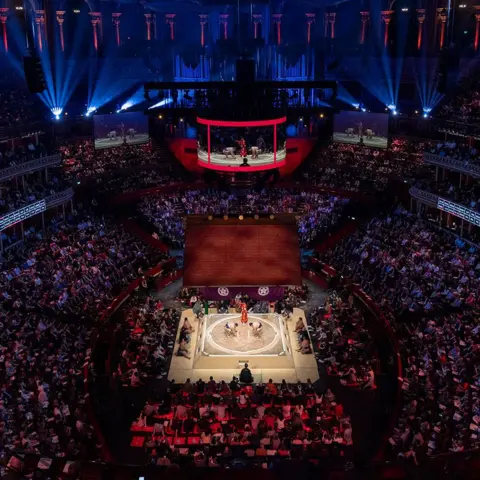 Getty Images
Getty ImagesThere are not many sports that can keep an audience enraptured through 45 minutes of ceremony before the first point is even contested.
And yet, the intricate traditions unfolding in a small clay ring – virtually unchanged in hundreds of years – managed to do just that.
Welcome, then, to the Grand Sumo Tournament – a five-day event at the Royal Albert Hall featuring 40 of the very best sumo wrestlers showcasing a sport which can date its first mention back to 23BC.
London’s Victorian concert venue has been utterly transformed, complete with six-tonne Japanese temple roof suspended above the ring.
It is here the wrestlers, known as rikishi, will perform their leg stomps to drive away evil spirits, and where they will clap to get the attention of the gods.
And above all this ancient ceremony, a giant, revolving LED screen which wouldn’t look out of place at an American basketball game, offering the audience all the stats and replays they could want.
Sumo may be ancient, and may have strict rules governing every aspect of a rikishi’s conduct, but it still exists in a modern world.
And that modern world is helping spread sumo far beyond Japan’s borders.
 Getty Images
Getty ImagesIt was a “random video” which first caught Sian Spencer’s attention a couple of years ago.
This was quickly followed by the discovery of dedicated YouTube channels for a couple of the sumo stables, where rikishi live and train, waking up early to practice, followed by a high protein stew called a chankonabe, and then an afternoon nap – all in the service of bulking up.
Then she discovered the bi-monthly, 15 day championships, known as basho, and from there, she was hooked.
The London tournament was simply a “once-in-a-lifetime”, not-to-be-missed, opportunity to see it all in real life, the 35-year-old says.
 Flora Drury/BBC
Flora Drury/BBCJulia and her partner Cezar, who live in Edinburgh, discovered sumo through a more traditional route: a trip to Japan six years ago.
“We saw it as a very touristy activity, but we actually ended up loving the sport,” says Julia, 34.
“From there on, we tried to find communities, information, just to learn more and more about it,” Cezar, 36, adds.
Colleagues, friends and family, they found, could be quite taken aback by their new passion.
“It’s the only sport we watch,” explains Julia – so they found like-minded people on messaging apps like Telegram.
“We found Italian groups, English groups,” says Julia.
“Outside of Japan, online is the only way to interact with the sport,” adds Cezar.
Going to Japan is almost the only way to see a top-flight sumo tournament.
This week’s event in London is only the second time the tournament has visited the city – the first time was in 1991 – while the last overseas trip was to Jakarta in 2013.
But even going to Japan isn’t a guarantee of getting a seat. Last year was the first time in 24 years that all six of the bi-monthly, 15-day events had sold out in 28 years, Kyodo News reported – fueled by interest at home, and by the tourist boom which saw more than 36m foreigners visit in 2024.
So for many, the London tournament is the first time they have watched sumo in person – and it doesn’t disapoint.
“Seeing it up close, you get a sense of the speed and the power which you don’t get on TV. It was incredible,” says Caspar Eliot, a 36-year-old fan from London. “They are so big.”
To win, one man needs to push another out of the ring or to the ground using brute strength. The majority use one of two styles to achieve this, often in split seconds – pushing, or grappling.
Either way, the sound of the two rikishi colliding in the first moment of the match reverberates around the hall.
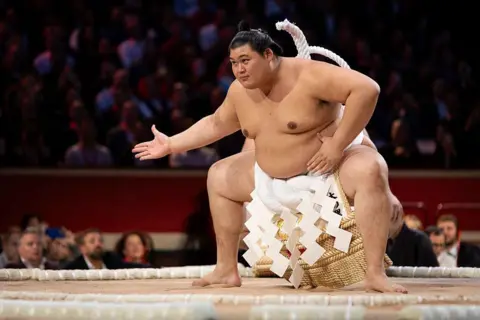 Getty Images
Getty Images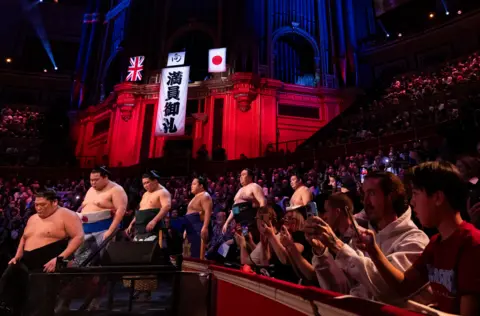 Getty Images
Getty Images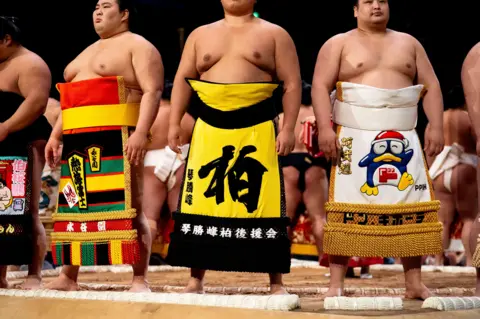 PA
PA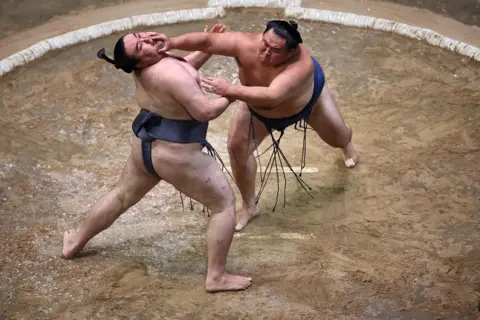 AFP via Getty Images
AFP via Getty ImagesCaspar and his wife Megha Okhai had been among those lucky enough to get tickets when they visited Japan last year – only for them not to arrive in the post in time.
It didn’t stop them falling head over heels, however, and they have watched every basho this year. So when it came to the London Grand Sumo Tournament, they weren’t taking chances.
“I think we had four devices trying to book tickets,” Caspar tells the BBC ahead of the event, displaying his sumo towels proudly – a must for diehard fans. “We got front row seats, on the cushions.”
The cushions right next to the ring are of course highly prized – but also, a bit risky.
On Thursday, it was all 181kg and 191cm of Shonannoumi which went plummeting into the crowd – perhaps making those in the slightly cheaper seats breathe a sigh of relief.
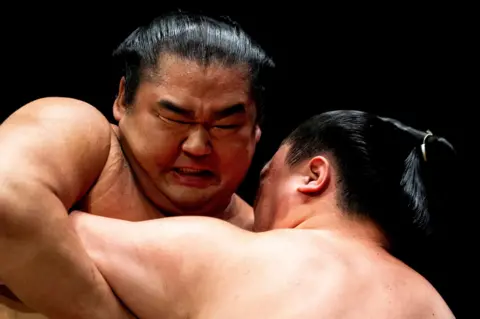 PA Media
PA Media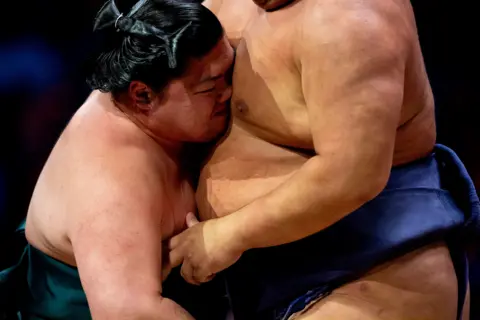 PA Media
PA Media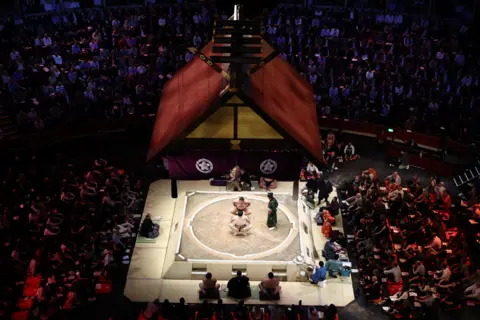 AFP via Getty Images
AFP via Getty ImagesOf course, the size of the rikishi is one of the first things most people think of when they think of sumo. The Albert Hall’s director of programming revealed to The Guardian earlier this week that they “had to source and buy new chairs which can take up to 200kg in weight”.
But sumo – for all its sell-out events – is not without its troubles behind the scenes. A series of scandals over the last couple of decades around bullying, match fixing and sexism have dented its image.
And then there is the fact that last year – while being a bumper one for ticket sales – saw the lowest number of new recruits joining the stables.
Perhaps the strict life of a rikishi doesn’t look as appealing as it once might have. Its popularity among young Japanese is also being threatened by other sports, like baseball. As Thomas Fabbri, the BBC’s resident sumo fan, said: “My Japanese friends think I’m mad, as they see it as a sport for old people.”
Japan’s falling birthrate will also not help – nor is the Japanese Sumo Association’s rule which restricts each stable to just one foreign rikishi. Despite this, Mongolians have dominated for the past few years – and one of the most exciting rising stars hails from Ukraine.

Not that any of this has worried fans in London.
“Seeing all this ritual and ceremony that goes with sumo is quite special,” fan Sian says. “Now, seeing it in person, you feel like you are more part of it.”
Julia and Cesar agree in a message the next day.
“It’s a Japanese sport but we didn’t feel out of place, so many people from all around the world around us.”
For Megha, the drama “made it so incredible” – as did meeting the other fans.
“Getting out of a very niche Reddit community and being able to see all these sumo fans in person and being able to chat with other people who are just as into this as we are – it was worth every penny of sumo gold.”
Additonal reporting by Thomas Fabbri
Want to watch? Audiences can tune in via BBC iPlayer, the BBC Red Button, the BBC Sport website and app.
